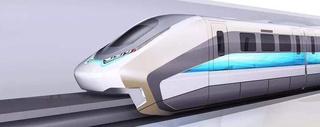Brand New 620 km/h Maglev Prototype
China showcased its newest maglev iteration, a prototype train with a designed speed of 620 km/h (385 mph) in Chengdu, southwest China's Sichuan Province. It uses the groundbreaking high-temperature superconducting (HTS) maglev technology for levitation and propulsion. Let's see all the details!

• The 21-meter-long silver-and-black locomotive has a super aerodynamic dolphin-faced design featuring a glass for the train operator that's shaped like a soda bottle
• 100% domestically developed by the researchers at the Southwest Jiaotong University, China Railway Group Limited, and CRRC Corporation Limited
• Developing the new maglev has cost 60 million yuan ($9.3 million)
• The functioning prototype was demonstrated on a 165-meter (540 feet) maglev test track in Chengdu
• Commercial availability is expected within six years
• The prototype uses carbon fiber and is about half the weight of its high-speed rail train counterparts
• The weight saving on the train also helps to reduce the cost of building infrastructure
• With a top speed of 620 km/h (385 mph), it's the fastest maglev train, beating the Japanese SCMaglev by 115 km/h (71 mph). The researchers claim that they were working on stretching that speed to 800km/h (497mph)
• A 50 km (31 miles) long test track is planned to be built to be able to test the top speed

• Researchers at Southwest Jiaotong University also said that their superconducting maglev technology is more economical than SCMaglev
• The Japanese Chuo Shinkansen maglev line used liquid helium to achieve that extreme low temperature of minus 269 degrees Celsius (minus 452 Fahrenheit) for superconductivity, while China’s high-temperature superconducting maglev is using liquid-nitrogen that slash the cost to one-fiftieth
• Other notable difference is that the Japanese SCMaglev needs to accelerate first before being able to levitate, while the Chengdu prototype can levitate from a standing start
• The new maglev is part of Beijing’s futuristic plan to create even faster links between cities
• It is the world's first vehicle to use the high-temperature superconducting (HTS) maglev technology
• The HTS technology will make it faster and lighter than its rivals
• Compared with other maglev technologies, HTS tech is more suitable for the futuristic concept of super-fast transportation in vacuum tubes (Hyperloop), where trains could hit speeds of over 1,000 km/h
• The HTS technology can make the train float without electricity, and it can be moved with just one hand. To demonstrate this, at the site, a reporter has pushed the 12-tonne levitated locomotive with one finger

• The maglev would cover the distance between London and Paris in 47 minutes at maximum speed
• Wu Zili, a senior engineer with the Southwest Jiaotong University, said the cost of the (HTS) maglev system is not much higher than the traditional high-speed rail, and with mass production, they could compete with the price
• They estimate the building cost of a new maglev line would be between 250 million yuan ($38.6 million) and 300 million yuan ($46.3 million) per kilometer, compared to 200 million yuan ($30.9 million) per kilometer for high-speed rail. This is before mass production is taken into consideration
• They plan to use the technology for a high-speed maglev link between Chengdu and Chongqing





